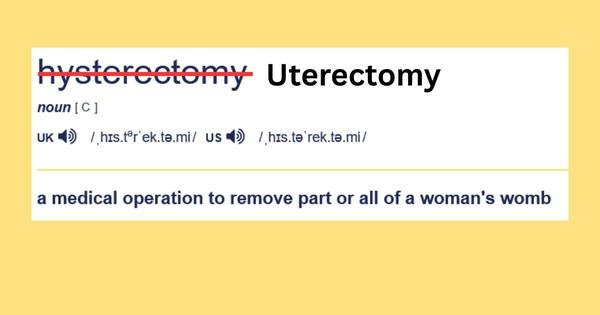Why We Should Rename Hysterectomy to Uterectomy

Have you ever had a tonsillectomy, appendectomy, or lumpectomy? These terms clearly describe the surgical removal of specific body parts. The suffix “ectomy” means surgical removal. This makes these procedures easy to understand.
So why is the removal of the uterus called a hysterectomy instead of a uterectomy?
The term hysterectomy comes from an outdated idea called “hysteria.” This was once believed to affect only women. We now know this condition doesn’t exist. Using the term hysterectomy continues to spread misinformation and causes confusion about the procedure.
The History of ‘Hysteria’
Hysteria was a condition first defined in the 5th century BCE. It had many symptoms, including excessive emotion, irritability, anxiety, breathlessness, and fainting. However, it was only diagnosed in women.
Doctors at the time claimed these symptoms were caused by a “wandering womb.” They believed the womb moved around the body, disrupting other organs. Because the uterus was blamed for hysteria, the treatment was to remove it. This procedure was called a hysterectomy. Sadly, many women had their healthy uterus unnecessarily removed, and most died.
The word “hysteria” came from the ancient Greek word for uterus, “hystera.” But the modern Greek word for uterus is “mitra,” which is where words like “endometrium” come from. Hysteria was only removed as an official medical diagnosis in 1980. It was finally recognized as non-existent and sexist.
The term “hysterectomy” should also be removed from medical terminology. It continues to link the uterus to hysteria.
Common but Confusing
About one in three Australian women will have their uterus removed. A hysterectomy is one of the most common surgeries worldwide. It’s used to treat conditions including:
- Abnormal uterine bleeding (heavy bleeding)
- Uterine fibroids (benign tumors)
- Uterine prolapse (when the uterus protrudes down into the vagina)
- Adenomyosis (when the inner layer of the uterus grows into the muscle layer)
- Cancer
However, in a survey of almost 500 Australian adults, one in five people thought hysterectomy meant removal of the ovaries, not the uterus. While some hysterectomies for cancer also remove the ovaries, the term should clearly indicate the nature of the surgery.
Research shows that unclear terms like “hysterectomy” lead to low patient understanding of the procedure and the female anatomy involved. The term “uterectomy” should be used for the removal of the uterus. This can be combined with medical terms for the removal of the cervix, uterine tubes, and ovaries as needed.
This change could help patients understand what is being removed from their bodies. It would also increase clarity for the wider public.
Male Names in Medicine
There are many eponyms (terms named after people) in anatomy and medicine. Examples include the Achilles tendon and Parkinson’s disease. These are almost exclusively the names of white men. Eponyms for female anatomy and procedures include the Fallopian tubes, Pouch of Douglas, and Pap smear.
The anatomical term for Fallopian tubes is uterine tubes. “Uterine” indicates these are attached to the uterus. This reinforces their important role in fertility. The Pouch of Douglas is the space between the rectum and uterus. Using the anatomical name (rectouterine pouch) is important because it is a common site for endometriosis. It can explain any associated bowel symptoms.
The term “Pap smear” gives no indication of its location or function. The new cervical screening test is named exactly that. This clarifies that it samples cells of the cervix. It helps people understand that this test is for the risk of cervical cancer.
Why Language Matters
Language in medicine impacts patient care and health. It needs to be accurate and clear. It should not include words associated with bias or discrimination. It should not disempower a person.
For these reasons, the International Federation of Associations of Anatomists recommends removing eponyms from scientific and medical communication.
Meanwhile, experts argue that it’s time to rename the hysterectomy to uterectomy. A hysterectomy is an emotional procedure with both physical and psychological effects. Not directly referring to the uterus perpetuates the historical disregard of female reproductive anatomy and functions. Removing the link to hysteria and renaming hysterectomy to uterectomy would be a simple but symbolic change.
Educators, medical doctors, and science communicators will play an important role in using the term uterectomy instead of hysterectomy. Ultimately, the World Health Organization should make official changes in the International Classification of Health Interventions.
In line with increasing awareness and discussions around female reproductive health and medical misogyny, now is the time to improve terminology. We must ensure the names of body parts and medical procedures reflect the relevant anatomy.



